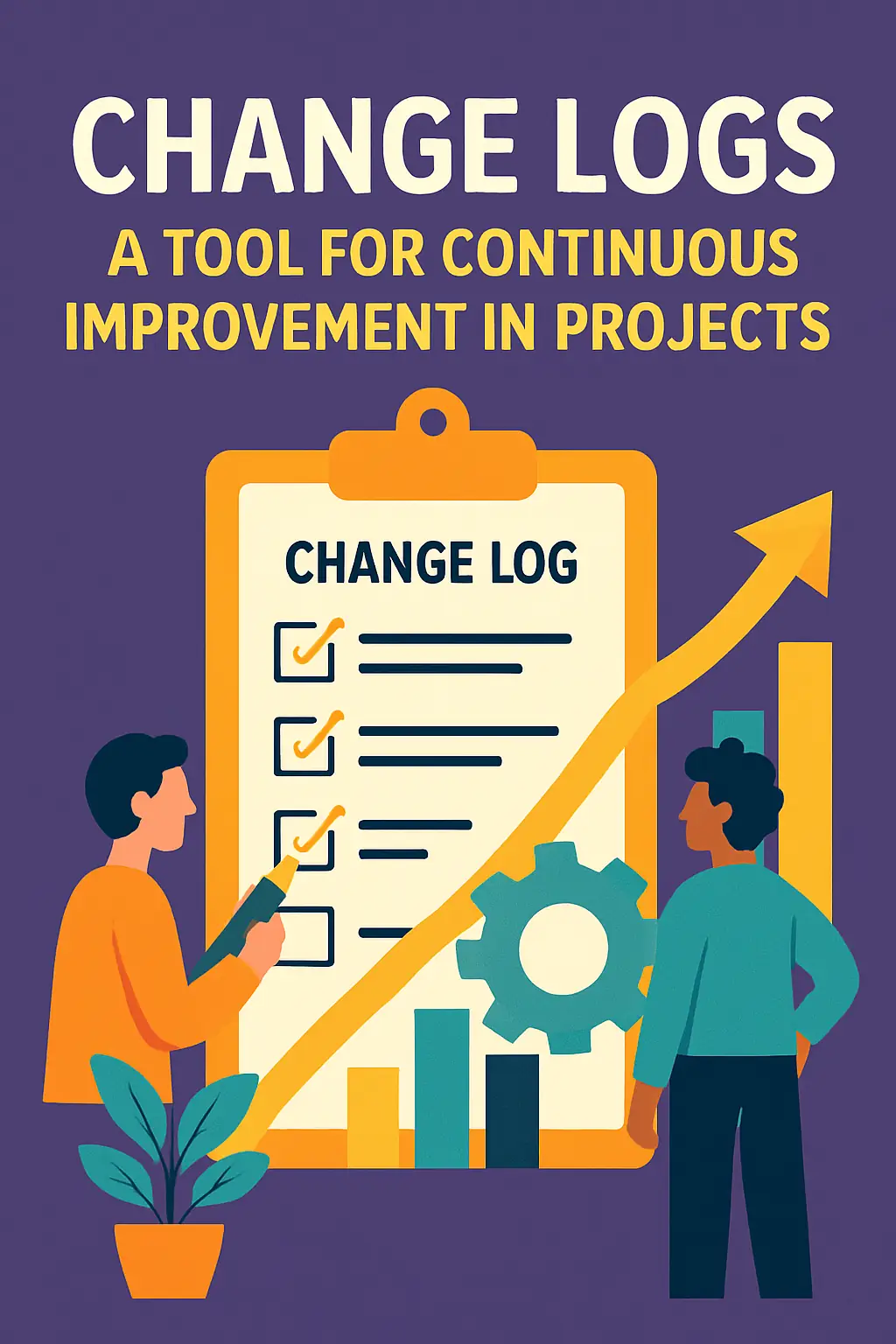Introduction
The ability to adapt and improve is crucial for success. One of the most effective tools for fostering this adaptability is the change log. A change log is a systematic record that tracks modifications, updates, or revisions made during a project. It serves as a central repository for documenting all changes that occur throughout the project lifecycle, including features, bug fixes, and updates. This documentation is not only vital for maintaining project integrity but also for ensuring that all stakeholders are informed about the project’s evolution [13][14].
The importance of documenting changes cannot be overstated. Throughout the project lifecycle, various factors can necessitate adjustments, whether they stem from stakeholder feedback, unforeseen challenges, or shifts in project scope. By meticulously recording these changes, project managers can maintain clarity and transparency, which is essential for effective communication among team members and stakeholders. This practice also aids in tracking the impact of changes on project timelines, costs, and overall objectives, thereby enhancing decision-making processes [10][15].
Moreover, change logs play a pivotal role in the continuous improvement process. By analyzing the documented changes, project teams can identify patterns, successes, and areas for improvement. This reflective practice allows teams to extract valuable lessons learned, which can be applied to future projects. The insights gained from reviewing change logs can lead to more informed planning, better risk management, and improved stakeholder engagement in subsequent initiatives [12][7]. In essence, change logs not only serve as a historical record but also as a strategic tool for fostering a culture of continuous improvement within organizations.
Understanding Change Logs
Change logs are essential tools in project management that facilitate continuous improvement by documenting alterations made throughout a project’s lifecycle. They serve not only as a record of changes but also as a means to identify lessons learned, which can significantly enhance the management of future projects. Here’s a comprehensive understanding of change logs, including their structure, content, and formats.
Typical Components of a Change Log
A well-structured change log typically includes several key elements that provide clarity and context for each change made. These components often consist of:
- Date: The date when the change was requested or implemented, which helps in tracking the timeline of changes.
- Description: A detailed explanation of the change, outlining what was altered and why it was necessary.
- Impact: An assessment of how the change affects the project, including implications for scope, schedule, and budget.
- Responsible Party: Identification of the individual or team responsible for implementing the change, ensuring accountability.
- Status: The current status of the change request (e.g., approved, rejected, or deferred), which aids in tracking progress and decision-making [10][12].
These components collectively ensure that all changes are documented comprehensively, allowing project managers and stakeholders to understand the evolution of the project.
Formats for Change Logs
Change logs can be maintained in various formats, each offering unique advantages:
- Spreadsheets: A popular choice due to their flexibility and ease of use. Spreadsheets allow for customization and can be easily shared among team members. However, they may require a learning curve for effective use and management [2][11].
- Software Tools: Many project management software solutions offer built-in change log functionalities. These tools can automate the tracking process, integrate with other project management features, and provide real-time updates, making them efficient for larger teams and complex projects [11].
- Manual Documents: Some teams may opt for traditional methods, such as maintaining a physical log or document. While this can be straightforward, it may lack the efficiency and accessibility of digital formats [11].
Selecting the right format depends on the project’s size, complexity, and the team’s preferences.
Differentiating Change Logs from Other Project Documentation
It is crucial to distinguish change logs from other forms of project documentation, as each serves a different purpose:
- Status Reports: These provide an overview of the project’s current state, including progress against milestones, resource allocation, and overall health. In contrast, change logs focus specifically on alterations made during the project [8][10].
- Meeting Minutes: While meeting minutes capture discussions and decisions made during project meetings, change logs document specific changes and their implications. Meeting minutes may reference changes but do not provide the detailed tracking that change logs do [8][10].
By understanding the unique role of change logs within the broader context of project documentation, project managers can leverage them effectively to foster continuous improvement and enhance future project outcomes.
The Role of Change Logs in Continuous Improvement
The concept of continuous improvement is pivotal. It refers to the ongoing effort to enhance products, services, or processes through incremental and breakthrough improvements. This philosophy encourages project managers and teams to regularly assess their practices, identify areas for enhancement, and implement changes that lead to better outcomes. Continuous improvement is not merely a one-time initiative; it is a culture that fosters adaptability and responsiveness to change, ultimately driving project success.
Change logs serve as a vital tool in this continuous improvement journey. They are systematic records that document changes made throughout a project, including modifications, additions, and fixes. By maintaining a detailed change log, project managers can track the evolution of a project over time, providing a clear picture of what changes were made, why they were necessary, and how they impacted the project’s trajectory. This documentation is essential for identifying trends and patterns in project changes, which can reveal valuable insights into the project management process.
Identifying Trends and Patterns
Change logs contribute significantly to recognizing trends and patterns in project changes. By analyzing the data captured in change logs, project managers can identify recurring issues or challenges that may arise during various phases of a project. For instance, if multiple entries in the change log indicate delays due to resource allocation, this pattern can prompt a reevaluation of resource management strategies. Similarly, if certain types of changes consistently lead to project delays or budget overruns, these insights can inform future planning and risk management efforts.
Moreover, change logs can highlight successful strategies that have led to positive outcomes. By reviewing past changes that resulted in improved efficiency or quality, project teams can replicate these successful practices in future projects. This reflective practice not only enhances the current project but also builds a repository of knowledge that can be leveraged across the organization.
Examples of Process Enhancements
Analyzing change logs can lead to significant process enhancements. For example, a project team may discover through their change log that a particular communication method consistently results in misunderstandings and subsequent changes. By addressing this issue—perhaps by adopting a more effective communication tool or strategy—the team can improve collaboration and reduce the need for future changes.
Another example could involve a software development project where the change log reveals that a specific feature frequently requires adjustments after initial implementation. This insight could lead to a redesign of the feature development process, incorporating more thorough testing and user feedback before finalizing changes. Such proactive measures not only enhance the current project but also contribute to the overall improvement of the development process.
Identifying Lessons Learned through Change Logs
Change logs serve as a vital tool in project management, particularly for continuous improvement advocates and project managers. By systematically documenting changes, updates, and resolutions, change logs not only provide a historical record of a project but also facilitate the identification of valuable lessons learned. Here’s how reviewing change logs can lead to enhanced project outcomes:
The Process of Reviewing Change Logs
- Regular Review Sessions: Establish a routine for reviewing change logs at key project milestones or after significant updates. This ensures that the team reflects on what has transpired and assesses the impact of changes made.
- Categorization of Changes: Organize changes into categories such as new features, improvements, and bug fixes. This categorization helps in pinpointing specific areas of success or failure, making it easier to analyze the effectiveness of each change [1][4].
- Identifying Patterns: Look for recurring issues or successful strategies within the change logs. For instance, if certain types of bugs are frequently resolved, it may indicate a need for improved testing protocols. Conversely, if specific features consistently receive positive feedback, they can serve as a model for future developments [5][10].
- Documentation of Lessons Learned: As insights are gathered from the change logs, document these lessons in a centralized location. This could be a dedicated section in the change log or a separate document that summarizes key takeaways from the project [9][12].
Case Studies of Successful Projects
- Software Development Project: A software development team utilized change logs to track the implementation of new features and the resolution of bugs. By reviewing the logs, they identified that user feedback on a particular feature led to significant improvements in user experience. This insight prompted the team to adopt a more user-centric approach in future projects, resulting in higher satisfaction rates and reduced support tickets [6][8].
- Construction Project: In a large construction project, the project manager maintained a detailed change log that documented not only changes in design but also adjustments in timelines and budgets. Upon reviewing the logs, the team discovered that delays were often linked to specific subcontractors. This led to a reevaluation of vendor relationships and improved project scheduling in subsequent projects, ultimately reducing delays by 30% [7][11].
Importance of Sharing Lessons with the Team and Stakeholders
Sharing the lessons learned from change logs is crucial for fostering a culture of continuous improvement. Here are some key reasons why this practice is beneficial:
- Enhanced Team Collaboration: When lessons are shared, team members can learn from each other’s experiences, leading to improved collaboration and innovation. This collective knowledge helps in avoiding past mistakes and replicating successes [10][12].
- Stakeholder Engagement: Keeping stakeholders informed about lessons learned builds trust and transparency. It demonstrates a commitment to improvement and can enhance stakeholder buy-in for future projects [5][10].
- Informed Decision-Making: By utilizing insights from change logs, project managers can make more informed decisions regarding resource allocation, risk management, and project planning. This proactive approach can significantly enhance project outcomes and stakeholder satisfaction [9][14].
Best Practices for Maintaining Change Logs
Change logs are vital for project management, serving not only as a record of changes but also as a resource for continuous improvement. To maximize their effectiveness, project managers should adopt best practices that ensure change logs are maintained accurately and regularly. Here are some actionable tips:
- Establish Guidelines for Regular Updates and Reviews: It is essential to set clear expectations for how often change logs should be updated. Regular updates—ideally at least weekly—should be part of the status management and reporting process. This practice ensures that all changes are documented promptly, which helps maintain an accurate and up-to-date record of the project’s evolution [3][14]. Additionally, conducting regular reviews of the change log can help identify patterns and areas for improvement, fostering a culture of continuous learning.
- Encourage Team Involvement in Documenting Changes: Involving the entire project team in the documentation process promotes ownership and accountability. When team members contribute to the change log, they are more likely to take responsibility for their work and understand the implications of changes made. This collaborative approach not only enhances the quality of the documentation but also encourages a shared commitment to project goals [10][11].
- Suggest Tools and Software for Enhanced Management: Utilizing tools and software can significantly streamline the management of change logs. Options range from simple spreadsheets to more sophisticated project management software that includes change log functionalities. These tools can automate updates, provide templates for consistency, and facilitate centralized storage of change logs, making it easier for teams to access and review changes [4][8]. By leveraging technology, project managers can ensure that change logs are not only maintained but also utilized effectively for future project planning and improvement.
By implementing these best practices, project managers can ensure that change logs serve as a valuable resource for identifying lessons learned and driving continuous improvement in future projects.
Challenges and Solutions in Change Log Management
Change logs serve as a vital tool in project management, enabling teams to document modifications, track progress, and identify lessons learned. However, managing change logs effectively can present several challenges. Below are some common obstacles along with strategies to overcome them, emphasizing the importance of fostering a culture of transparency and continuous improvement.
Common Challenges in Change Log Management
- Resistance to Documentation: Team members may resist the practice of documenting changes, viewing it as an additional burden rather than a beneficial process. This resistance can stem from a lack of understanding of the value that change logs provide in tracking project evolution and facilitating communication among stakeholders [10].
- Time Constraints: Project managers and team members often face tight deadlines, leading to the prioritization of immediate tasks over documentation. This can result in incomplete or inconsistent change logs, which ultimately hinder the project’s ability to learn from past experiences [11].
- Lack of Clear Goals and Success Criteria: Without well-defined objectives for what the change log should achieve, teams may struggle to maintain focus and consistency in their documentation efforts. This can lead to confusion and a lack of actionable insights from the change log [2].
- Integration with Existing Processes: Change logs may not be seamlessly integrated into existing project management workflows, making it difficult for team members to adopt them consistently. This disconnection can lead to underutilization of the change log as a resource for continuous improvement [1].
Strategies to Overcome Challenges
- Simplifying the Process: Streamlining the documentation process can help alleviate resistance. By creating user-friendly templates and guidelines, project managers can make it easier for team members to log changes without feeling overwhelmed. This can encourage more consistent use of change logs [1].
- Integrating with Project Management Tools: Leveraging existing project management software to incorporate change log functionalities can enhance usability. By integrating change logs into tools that team members already use, it becomes a natural part of their workflow, reducing the likelihood of resistance and improving documentation consistency [1][12].
- Fostering a Culture of Transparency: Encouraging open communication about the importance of change logs can help build a culture of transparency. When team members understand that documenting changes contributes to collective learning and project success, they are more likely to engage with the process. Regular discussions about lessons learned from change logs can reinforce this culture [10][15].
- Setting Clear Goals and Success Criteria: Establishing clear objectives for the change log can guide team members in their documentation efforts. By defining what constitutes a successful change log and how it will be used to inform future projects, teams can maintain focus and ensure that their documentation efforts yield valuable insights [2][11].
Conclusion
Change logs serve as a vital tool for fostering continuous improvement. By meticulously documenting changes made throughout a project’s lifecycle, change logs not only provide clarity and organization but also facilitate the identification of lessons learned. This reflective practice enables project managers to analyze what worked well and what did not, ultimately leading to enhanced decision-making in future projects.
Key takeaways regarding the importance of change logs include:
- Structured Documentation: Change logs offer a systematic way to track modifications, ensuring that all team members and stakeholders are informed about the evolution of the project. This transparency is crucial for maintaining alignment and accountability among team members [11][13].
- Facilitating Learning: By reviewing change logs, project managers can extract valuable insights that inform future initiatives. This process of reflection helps in recognizing patterns, understanding the impact of changes, and applying these lessons to improve project outcomes [9][12].
- Standard Practice Adoption: It is essential for project managers to adopt change logs as a standard practice within their teams. This not only enhances project management efficiency but also cultivates a culture of continuous improvement, where every project is seen as an opportunity to learn and grow [1][8].
Find out more about Shaun Stoltz https://www.shaunstoltz.com/about/.
This post was written by an AI and reviewed/edited by a human.



